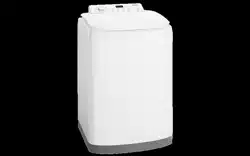Documents: Go to download!
User Manual
- Owner's manual - (English)
- Simpson SWT6541 6.5kg Top Load Washing Machine Installation Guide - (English)
- SWT6541 - Simpson - Specifications Sheet - (English)
- PRODUCT DESCRIPTION
- CONTROL PANEL
- WASHING INSTRUCTIONS
- DAILY USE
- CARING FOR YOUR WASHING MACHINE
- TROUBLE SHOOTING
Table of contents
User manual Washing Machine
PRODUCT DESCRIPTION
WASHING MACHINE PARTS
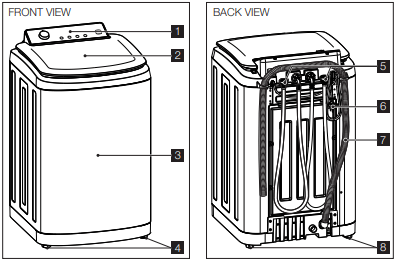
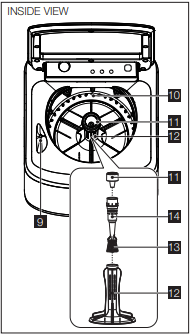
PARTS LIST
- Control Panel
- Lid
- Cabinet
- Levelling Adjustable Front Feet
- Water Inlet Hose: RED fittings (Hot Water), BLUE fittings (Cold Water)
- Mains Cable
- Outlet Hose/Drain Hose (See installation instructions sheet to fit & position drain hose)
- Back Feet (fixed)
- Bleach Dispenser
- Wash Bowl
- Fabric Softener Dispenser
- Agitator
- Lint Filter
- Frame Filter
PRODUCT FEATURES
The Simpson wash system
1) Wash operation
The agitator & bowl rotates while it is filled with water to immerse the clothes.
The agitator then rotate to move the clothes so that the detergent can be dissolved and activated at the selected water temperature.
2) Agitation and dilution
After the wash operation is completed, the bowl is filled with more water. The agitator then moves in an energy efficient mode, generating additional mechanical actions.
Auto Clear Unbalance
The washing machine can stop during the spin stage of a wash or spin because of an out of balance condition. Out of balance during spin is caused by an uneven distribution of clothes in the wash bowl. If the washing machine detects this problem, it will try to clear itself by following the steps below:
1. Stop spinning then starts filling to the selected water level.
2. Agitates for 3 minutes to redistribute the clothes.
3. Drains the water.
4. Starts the spin cycle again.
NOTE
- If the machine detects the problem again, it will repeat self clearing steps one more time. If problem reoccurs the third time, “ ” will be displayed along with 3 short beeps repeated 3 time every 15 seconds to get your attention. To rectify the out of balance condition, open the lid and wait until the machine stops spinning, then redistribute the clothes evenly in the space between the agitator and wall of the wash bowl. Close the lid and press the “Start/Pause” button to continue the spin stage.
- If you have frequent out of balance interruptions, it may be due to your washing machine not standing firm and level on the floor. This can be corrected by adjusting the washing machine legs as described in the Installation Instructions sheet supplied with your machine.
- If “Eco” rinse option selected, this function will not operate.
- This function will not operate in “Tub Cleaning” and Drain + Spin” programs.
- If “Extra” rinse option is selected, self clearing steps will be repeated up to 6 times.
Power Failure Recovery
When there is power failure while machine is washing or rinsing or spinning. The machine tries to save the settings at which stage the machine is doing and then when the power returns back the machine will starts washing from the stage where it is left off.
Button Response and Lights
Always press buttons gently. Watch the lights on the control panel to see the effect pressing a button or turning a program selector knob has, and listen for “BEEPS”.
When you press a button you will get a short “BEEP” to acknowledge the entry. If the option is not available at the time, the machine will not allow you to select it, and you will here the three short “BEEP” to remind you the option is not available and the display will show “ ” and flashing.
After the machine has started, the entire wash option button will be disabled and the display will show “ ” and flashing with three short beeps to indicate the button is disabled (except Start/Pause button).
Enabling/Disabling End-of-Wash Beeping Mode
This mode permits you to either enable or disable the beeping (3 beeps every 20 seconds) at the end of the wash. As an example, you might wish to disable this beeping when you start a wash when going to bed, so that when the wash finished, it will not disturb you through the night.
To change the “beeping” selection, proceed as follows:
- If you want to DISABLE the “beeping” sound, when the washing machine in Stand-By-Mode (after 7 seconds passed from machine switching on), press “Soak Time” and “Water Level” buttons at the same time until you hear 2 shorts “BEEP” sound.
- To return to default configuration press these 2 buttons at the same time until you hear “BEEP” sound.
NOTE:
- All error beeping is not disabled by this feature, such as a critical fault, or lid open during fill/agitate/spin, or out of balance during spinning.
- Responding sound while pressing the button is not disabled by this feature.
CONTROL PANEL
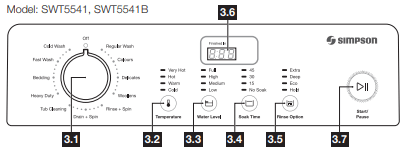
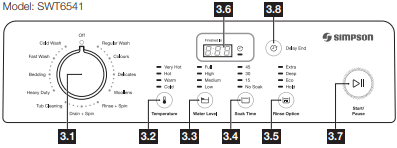
PROGRAM SELECTOR KNOB
Turn the Program Selector knob to choose the wash program you want. The table “Your Program Guide” shown on page 12 will help you in selecting the right program.
The Program Selector knob is not a timer. Once you select a wash program, the Program Selector knob will stay at that position for the whole wash cycle.
NOTE: When you choose the Woollens and Bedding program, the Deep Rinse option is automatically selected for you. You will NOT be able to select and use Eco Rinse with these two programs.
WATER TEMPERATURES BUTTON
For each wash program your washing machine automatically selects a suitable fill water temperature. If you want to use a different wash water temperature, press the Temperature button repeatedly.
The water temp lights will tell you the temperature for each press of the button.
You have four temperatures to choose from Very Hot, Hot, Warm and Cold.
The temperature of warm water will depend on the temperature and pressure of your hot and cold water supplies. The recommended temperature for warm is 35°C.
You can adjust the flow rate of the water supplies to adjust the Warm temperature. All rinse water temperatures are cold.
Always check your label for the washing temperature symbols which the International Care Labelling Code now uses.

NOTE:
If you have a cold water connection ONLY and the hot inlet valve is capped off (refer installation instructions) you must select Cold washes only. To fill detergent, you must follow steps as below:
1. Measure the correct amount of powder detergent by following the recommendations on the package.
2. Mix powder detergent in one litre of hot or warm water.
3. Add the pre-mixed detergent to the wash load.
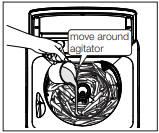
WATER LEVEL BUTTON
Choose the water level by pressing Water Level button. Use only the amount of water you need for the wash load.

1) Model SWT5541, SWT5541B Maximum mass of dry cloth is 5.5kg
2) Model SWT6541 Maximum mass of dry cloth is 6.5kg
Proportion of Hot and Cold water based on temperature selection.

IMPORTANT: Components in the washing machine are designed to be used with water no hotter than 70°C. If your water supply is too hot, you should have a temperature limiting valve fitted by a qualified plumber.
SOAK TIME BUTTON
This option allows you to soak heavily soiled clothes at the beginning of the wash. To do this, press Soak Time button to select the soak time.
The lid must be closed to allow Soak functions to operate, including the “Heavy Duty” wash program 6 mins soak. The machine will agitate for short periods. At other times, the clothes are soaking and the machine will be doing nothing.
RINSE OPTION BUTTON
Pressing the Rinse Option button to choose the rinse type for your wash load. For most washes the machine automatically selects “Deep” rinse for you.
There are four rinses to choose from Extra, Deep, Eco and Hold.
- Extra rinse, the machine fills twice, giving you two deep rinses.
- Deep rinse, the machine fills once, giving you one deep rinse.
- Eco rinse, is a spray rinse giving you maximum water saving.
- Hold, by selecting this option the water of the last rinse is not emptied out and the drum turns regularly to prevent the laundry creases.
After cycle has finished, You must drain the water from the washing tub by pressing “Start/Pause” button to continue the cycle.
How does Eco Rinse work ?
When Eco rinse is used, rinse water is sprayed into the washbowl in pulses. After each pulse the washbowl will spin to remove detergent laden water from the clothes.

The machine will go through a series of maximum six pulses spray and short spin cycles in this manner, depending on program selection, followed by a final long spin that removes the water from the clothes to complete the full wash program.
NOTE:
- Compare this with Deep rinse where much more water is used.
- Deep rinse, water enters the machine filling up to the wash water level selected. The washer agitates and finally empties the rinse water through the drain hose.
- Extra rinse, this is special option for those people who suffer from allergies, this extra rinse will provide two deep rinses to ensure all detergent residue has been removed.
- Eco Rinse CANNOT be selected with Woollens and Bedding program.
- Extra and Eco rinse is not designed to be used with fabric softener.
- Select Deep rinse if you are going to use fabric softener.
- Deep rinse ensures the fabric softener is correctly dispensed and thoroughly removed from your clothes during rinsing.
DISPLAY
The display shows the following information:
Machine In Pause Mode

You can tell when your washing machine is in pause mode. The time remaining and “ ” will be flashing.
Estimated time of the selected program

After selecting a program, the estimate time is displayed in hours and minutes (for example 1.04). The estimate time is calculated automatically on the basis of the maximum recommended load for each type of fabric. After the program has started, the time remaining is updated every minute.
End Of Program

When the program is completed the 3 zeros will flash.
Alarm Codes

In the event of operating problems, some alarm codes can be displayed, for example E2o (see “Troubleshooting” and “Troubleshooting fault displays” on page 26, 27, 28).
Incorrect Option Selection

If an option which is not compatible with the set wash program is selected, the display will show “ ” and flashing with 3 consecutive short beeps
” and flashing with 3 consecutive short beeps
START/PAUSE BUTTON
To start the selected program, press the “Start/Pause” button.
If you have started your wash and you wish to stop it for some reason, press the “Start/Pause” button to enter PAUSE mode. To restart the program from the point at which it was interrupted, press the “Start/Pause” again.
If the lid has been opened any time during operation of the machine, the Start/Pause button has to be pressed when the lid is closed to continue operation.
DELAY END OPTION BUTTON (Only Model SWT6541)
Before you start the program, this option makes it possible to delay the end of the washing program by 2, 4, 6, 8, 10 or 12 hours, by pressing Delay End button to choose the end time as your wish. This option must be selected after choosing the wash program, and before pressing the “Start/Pause” button. If after having set the Delay-End option (and pressed “Start/Pause” button) and you wish the cancel or modify it, follow the below steps:
- set the washing machine to PAUSE by press “Start/Pause” button;
- deselect the Delay-End option, changing the status;
- press the “Start/Pause” to start the program.
YOUR PROGRAM GUIDE
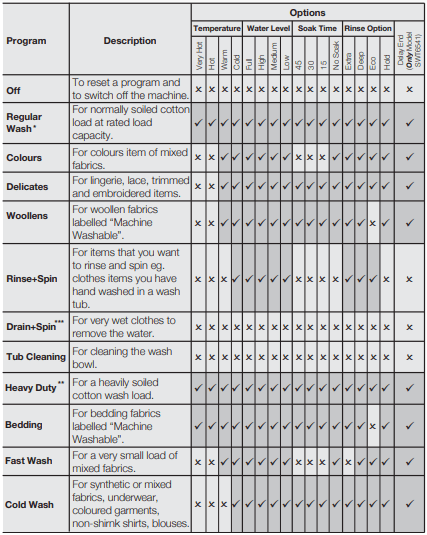
Remarks
* “Regular Wash, Warm Temp, Full Water Level, No Soak, Eco Rinse” is recommended for a full load of normally soiled cottons.
** “Heavy Duty” has a built-in Soak period of 6 minutes.
*** ** “Drain+Spin” has a built-in pump out period of approx. 2 minutes prior to spin.
WASHING INSTRUCTIONS
These Washing Instructions are of a general nature and you should get good wash results by following them.
However, due to the variables of fabric types, soil levels, detergent types and available program settings you may find some combinations of these which do not always result in the perfect wash.
If for example you see residuals of detergent or soils on some items, please read the section Residues on washed items paragraph.
Over time you will learn what is the best set-up of programs, detergent and load sorting for different load types and soils.
SORT YOUR WASHING INTO SEPARATE WASH LOADS

- Each load of washing should contain clothing which needs the same washing conditions. For example, you should not wash delicate clothes with very dirty work clothes.
- Colour fast and non-colourfast fabrics should be separated. Knowing the type of fabrics you have and how dirty they are will help when you make selections from the wash program options.
- Some fabrics are lint collectors and can pick up lint, dirt and colour from other fabrics which are lint producers. Some examples are listed below:

NOTE:
Make sure that you wash lint collectors separately from lint producers.
- Never wash whites and coloureds together. Whites may lose their “whiteness” in the wash.
- New coloured items may run in the first wash; they should therefore be washed separately the first time.
IMPORTANT! Make sure that no metal objects are left in the laundry (e.g. hair clips, safety pins, pins).
- Button up pillowcases, close zip fasteners, hooks and poppers.
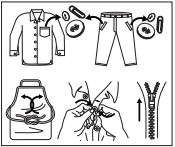
- Tie any belts or long tapes.
- Remove persistent stains before washing.
- Rub particularly soiled areas with a special detergent or detergent paste.
- Treat curtains with special care.
- Wash bras, pantyhose and other delicates in a mesh laundry bag, which you can purchase from your supermarket.
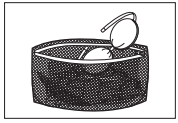
Remove hooks or tie them up in a bag or net.
PRE-TREATMENT SPRAYS AND STAIN REMOVERS
WARNING!
Pre-treatment sprays and stain remover can damage plastic components on your washing machine.
If you use pre-treatment sprays or stain removers, apply them to the clothing well away from your washing machine.
DETERGENT
Good washing results also depend on the choice of detergent and use of the correct quantities to avoid waste and protect the environment.
Although biodegradable, detergents contain substances which, in large quantities, can upset the delicate balance of nature.
The choice of detergent will depend on the type of fabric (delicates, woollens, cottons, etc.), the colour, washing temperature and degree of soiling.
- Don’t use the wrong type of detergent. You must use a low sudsing detergent designed for front load washing machines or high efficiency top loaders, such as Cold Power for Front Loaders and High Efficiency Top Loaders or detergents labelled “Matic”.
- Don’t use soap-based products in your washing machine.
- Don’t use too much detergent. This can result in excessive suds that can cause low spin speeds, poor rinsing and overloading the motor during spin stages of the wash program.
- Don’t use too little detergent because you will get a poor wash. If you think you need more, increase dosages by only small amounts to avoid excessive suds.
DAILY USE
STARTING YOUR WASHING MACHINE
1. Connect the mains plug to the mains socket.
2. Turn the water tap on.
LOAD THE WASHING MACHINE
When loading the clothes into your washing machine, there are four things to remember:
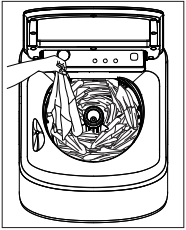
- Clothes must be loaded evenly around the agitator. For best results load small items first, followed by large items.
- Clothes must not be wrapped around the agitator.
- The washing machine must not be overloaded. Clothes must be able to move during wash.
- The load should contain only three or four large items, for example sheets. The rest of the load should be small items. A mixed load of large and small items will wash cleaner than a load of all large items.
ADD THE DETERGENT
- Measure the correct amount of powder or liquid detergent by following the recommendations on the package.
- Mix detergent in one litre of hot or warm water.
- Add the pre-mixed detergent to the wash load.
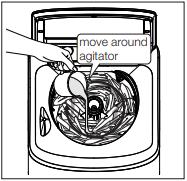
Don’t do these things:
- Using too little detergent will give you a poor wash result.
- Using excessive detergent will create too much suds and may cause overloading of the motor during the spin stage of the wash cycle. To avoid excessive suds, reduce the amount of detergent you use. It is best to use detergent labelled low sudsing. Good quality, front load detergent will perform well in this machine.
- Use soap based products in your washing machine.
ADD FABRIC SOFTENER
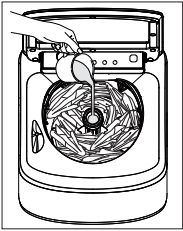
1. Measure the correct amount of fabric softener by following the recommendations on the package.
2. Mix softener with an equal amount of warm water but only mix enough to fill to the line marked inside the cup. The softener cup holds 75ml.
3. Pour the mixed softener into the cup in the top of the agitator. Do not overfill the cup. Do not spill fabric softener on the clothes as it may stain them.
4. If you are going to use fabric softener, you must select the DEEP RINSE option, ie deselect the ECO RINSEoption.
NOTE: You do not have to use fabric softener, your washing machine will wash the clothes perfectly well without it.
ADDING BLEACH
Bleaching of clothes can help to remove stains, heavy soiling and to kill bacteria.
Oxygen Type
This is generally a powder type bleach. Mix the required quantity with water and pour down the bleach hole in the top panel during the fill when there is some water in the washbowl.
Chlorine Type
This type of bleach should not be mixed with detergent. Mix the bleach with water as per the instructions on the container.
How to soak with bleach, proceed as follows:
1. Turn Program Selector to a Regular Wash position.
2. Press the Start/Pause button to commence water fill.
3. Pour the bleach solution down the hole in the top panel during fill when there is some water in the wash bowl.
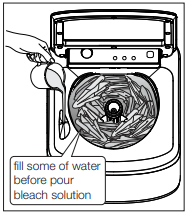
4. Allow the machine to agitate for a few minutes, then let it stand for the required time by pressing Start/Pause button to pause the machine.
5. When soaking bleach reached to the required time, turn Program Selector to Drain+Spin position and press the Start/Pause button to empty the wash bowl.
SETTING A PROGRAM
1. Turn the program selector to the required program.
- Your washing machine is now in STAND-BY-MODE and ready to wash your clothes.
- The relevant light will light up.
- The buzzer will sound.
- The selector dial can be turned either clockwise or anticlockwise.
- Once you selected a program, the program selected will stay at that position for the whole of the cycle.
- The display shows the program duration.
If the settings shown on the control panel are what you want to use, press the Start/Pause button to start your wash.
2. If you want your laundry to be washed with functions different from the one proposed by the machine, press Temperature, Water Level, Soak Time and Rinse Option buttons.
NOTE:
- Different functions can be combined which is dependent on the program selected.
- When these buttons are pressed, the corresponding pilot lights come on.
3. If you want to define the end of the washing program, press the “Delay End” button repeatedly to choose your machine end time.
STARTING A PROGRAM
To start a program, press the Start/Pause button, a default program duration will be displayed on the screen.
NOTE
When you select the Drain+Spin program, there will be a delay of at least 2 minutes before the washing machine starts to spin. This delay is a pump out (Drain) period to ensure the bowl is empty of water, which is necessary before spin commences. Even though you may have only put wet clothes into an empty bowl, the delay before spin will still occur to be safe and to protect your washing machine.
INTERRUPTION OF A PROGRAM
If you have started your wash and you wish to stop it for some reason, press the Start/Pause button to enter PAUSE mode. The time remaining is shown then “SP”.
Press the Start/Pause again. The program will continue.
CHANGING A PROGRAM
You can turn the Program Selector Knob to a new program position at any time. If you do move the Program Selector Knob the effect will be different depending on the status of the machine at the time you do this, as follows:
- When the machine is in PAUSE mode, moving the Knob to a new position will result in the machine resetting to the start of the new program.
- When the machine is running, moving the Knob to a new position will result in the machine continuing the wash and the display will show “
 ” and flashing with 3 consecutive short beeps to remind you that this option is not allowed.
” and flashing with 3 consecutive short beeps to remind you that this option is not allowed.
CHANGING THE OPTIONS
It is possible to change only some option after the program has started.
- Press the Start/Pause button to enter PAUSE mode.
- Change the options.
- Press Start/Pause button again. The program will continue.
AT THE END OF THE PROGRAM
- The appliance stops automatically.
- The display will show “000” and flashing with 3 consecutive long beeps.
- Turn the Program Selector knob to the position “Off”.
- Remove the laundry from the appliance. Make sure that the washing tub is empty.
- Keep the lid ajar, to prevent the mildew and odours.
- Turn off the water tap.
CARING FOR YOUR WASHING MACHINE
Your washing machine will give you long and trouble-free service, if you follow the instructions in this section. These instructions show you how to care for your washing machine.
WHAT TO DO AFTER YOU HAVE FINISHED YOUR WASHING.
- Turn the Program Selector knob to the position “Off”.
- Switch off the electricity at the power point.
- Turn off the water taps. This will extend the life of the inlet hoses.
- Leave lid open for a while. This allows time for moisture inside the washing machine to evaporate and for any odours to disperse.
CLEANING THE LINT FILTER
Lint is a collection of threads and fluff which comes off your clothes during washing. Your washing machine collects this lint in the lint filter. It is important to clean out this lint filter preferably after each wash.
How to clean the lint filter:
1. Remove the softener dispenser cup and filter column from the centre of the agitator.
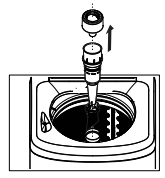
2. Unclip the filter bag from the column.
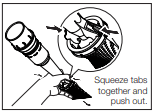
3. Turn the bag inside out and remove the lint.

4. Wash the filter bag and dispenser cup in hot water.
5. Reassemble the filter to the column and place it back in the centre of the agitator.

CLEANING YOUR WASHING MACHINE
To clean the inside and outside of your washing machine you should:
- Wipe the surface with a mild dishwashing detergent and warm water.
- Wipe dry with a soft cloth.
IMPORTANT: Never use solvents, alcohol, aerosol cleaners, spray pack cleaners, glass cleaners, metal polishes, caustic materials, scourers or general household cleaners on or near the top panel and lid, control panel or other parts of your washing machine.
CLEANING STAINS IN THE WASHBOWL
Stains in the wash bowl can be caused by:
- metal objects such as bobby pins, dressmaking pins and nails;
- salt;
- body oils and grease from very dirty or sweaty clothes being deposited around the top of the washbowl;
- excessive foam during wash if incorrect or too much detergent is used.
IMPORTANT:
- Check all pockets before loading clothes into your washing machine.
- Don’t leave wet clothing (especially swimwear) in the bowl for too long before you wash it.
How To Clean the Stainless Steel Wash Bowl :
- Wipe with a cleaning product which is marked suitable for stainless steel.
- Oily deposits can be removed by wiping surfaces with a mild dishwashing detergent and warm water.
IMPORTANT: Never use bleach cleaners or steel wool to clean the stainless steel washbowl.
AVOIDING BUILD UP OF UNDISSOLVED DETERGENTS
If you only wash with cold water, undissolved detergent and body oils will build up in the washing machine. This build-up can cause spotting on your clothes.
To avoid this build-up :
- do not use too much fabric softener with cold water;
- select a hot water wash at least once a month;
- always dissolve the detergent in one litre of warm water.
TROUBLE SHOOTING
DO NOT call for service until you have checked the points listed below.
If you call for service and there is nothing wrong with your washing machine, you will have to pay for the service call.
You will have to pay even when your washing machine is under warranty. Before you call for service, check the points in the table below.
Machine not working.
- Power not switched on.
- No electricity supply through the power point.
Switch on power point.
Check power point with another appliance.

- Water taps not turned on.
Turn on taps.

- Out of balance switch off.
Open lid, redistribute load and close lid.

- Lid not fully closed.
Close lid.
Machine has washed load but will not spin.

- Out of balance.
Open lid, redistribute load, close lid.

- Lid not fully closed.
Close lid.
Water in wash bowl.

- Drain hose blocked.
Check drain hose for blockage. Wait a short while, the wash will continue.
Will not fill with water.

- Water taps not turned on.
Turn taps on.
- Inlet hoses blocked.
Clean tap filters/washers.
Water flowing into wash bowl indefinitely.

- Drain hose too low.
Raise drain hose or fit a syphon break.
Refer to installation instructions for correct positioning of hose.
Machine goes out of balance or vibrates excessively when spinning.

- Machine not level.
Make the machine level.
- Levelling feet not adjusted.
Adjust feet to touch the floor.
- Clothes not evenly distributed.
Redistribute clothes evenly.
Water on floor.
- Loose inlet hose connections.
Check connections at taps and rear of machine.
- Loose drain hose connections.
Check connections at rear of machine.
- Condensation from hot water
Water splash.
- Clothes too much.
See maximum clothes load on page 9.
- Machine not levelled.
Level the machine properly.
- Water Level selection not correct.
See water level description on page 9.
Clothes still dirty after wash program.
- Not enough or no detergent.
Check detergent use and rewash clothes.
- Too many clothes in load.
Remove some clothes and rewash.
- Incorrect wash program or temperature selected.
Reselect program or temperature and rewash.
Scraping noise on spin.
- Bra wire or other thin items caught between inner and outer washbowls.
If the item is visible, remove it with pliers.
Use a wash bag in future.
Humming, clicking and other noises.
- Bowl rotation at start of wash.
Normal noise.
- Brake activation when stopping after spin.
Normal noise.
TROUBLESHOOTING FAULT DISPLAYS
Fault information and a guide for when you should call for service.
If you have a problem with your washing machine and before you call service, make sure you have followed ALL of the instructions that may remedy the problem. You will find instructions in the ‘Troubleshooting’ section and in the table below.
When the washing machine detects a problem that requires your attention, you will be alerted. The machine will warn you of this problem by displaying a fault code in the digital display, accompanied by “Beeping”.
Fault information and the action you should take are described in the following table.
Not filling with water
Make sure both wall taps are on and hose filters are not blocked. Raise drain hose if water is flowing out of drain hose. Press “Start/Pause” to re-start wash.
If problem remains, call Service.
Flood
If the water is pouring onto the floor, turn OFF both wall taps. Wait a few minutes to see if the fault is corrected.
If not, call Service.
Draining problem
Wait a few minutes to see if the fault is corrected. If not, set the washing machine to PAUSE by press “Start/Pause” button then check the drain hose for blockage. Press “Start/Pause” to continue the wash.
If problem remains, call Service.
Loss of water, while washing
If water level in wash bowl is low and water is flooding the floor, rotate the PROGRAM KNOB to “Drain + Spin” program, then press “Start/Pause” button.
Should this make things worse, turn off the machine and call Service.
Otherwise, press “Start/Pause” to continue the wash.
Water level problem
Wait, this fault may clear itself. If not, rotate the PROGRAM KNOB to “Drain + Spin” program, then press “Start/Pause” button to drain the wash bowl.
If this problem is repeated, call Service.
See other models: SDV601 SWT6055TMWA SWT1043 SWT7055LMWA SWT6041

